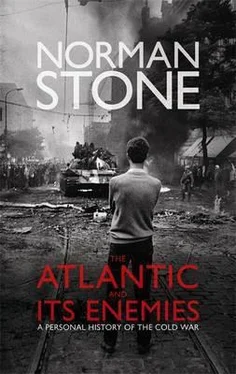Nixon’s response was to withdraw American troops, promising to ‘Vietnamize’ the war. This had mixed results. The Delta was made safe again, but there was now in 1970 a full-scale war going on along the borders, and the North Vietnamese were quite well equipped to fight it — T54 tanks, 130mm anti-aircraft artillery and 350,000 Chinese to back them up. Cambodia was almost safe reserve territory for them, because King Sihanouk, in 1964, believed that ‘all of south-east Asia is destined to become Communist’, and he allowed the Vietcong tacitly to use his port, Sihanoukville, where better-off Cambodians made money from smuggling to the Vietcong. In 1969 Nixon had stealthily bombed the Cambodian trails while the Vietcong trained Khmer Rouge (12,000) as guerrilleros , whereat mobs in Phnom Penh sacked the Vietnamese embassy and killed local resident Vietnamese. Sihanouk went to Moscow and Peking to have the Communists taken out of the country and was himself exiled — taking up an alliance with the Khmer Rouge even though they went on to kill some of his children. Nixon deviously supported the man who replaced him, a general by the name of Lon Nol (even the CIA heard about this only when Nixon announced it on TV). The bombing in 1970 shattered just huts, and Nixon had acquired another brittle and touchy ally (when Lon Nol was offered sanctuary in the embassy when it all collapsed he refused, blaming the Americans for scuttling from the scene); an attempt to use South Vietnamese troops broke down when they were ambushed. In February 1971 another effort was made, this time to cut the Ho Chi Minh Trail at Lam Son, and this was even worse. The Vietcong knew what was coming, and when the South Vietnamese had lost 3,000 men, President Nguyen Van Thieu ordered a retreat, but without telling the Americans. The retreat turned into a rout, fleeing soldiers clinging desperately to the skids of helicopters, and being torn to pieces by the treetops. There were even anti-American demonstrations in Saigon, and by now the Americans themselves were widely demoralized: to counter the use of heroin, urine tests had to be imposed on the army. In 1972 the North Vietnamese made a great effort to break the South. In March 40,000 men attacked over the 17th Parallel into the DMZ. In the first two weeks, there was a South Vietnamese collapse, made much worse because the roads were clogged by fleeing civilians and soldiers’ families — in fact by now there were 5 million refugees in a population of 17 million. An important base, Quang Tri, fell, and only vast US bombing stabilized the front.
Maybe South Vietnam could have been saved, but by 1971 the chief foundation of the American hegemony was collapsing: in mid-August 1971 Nixon refused to honour the gold bills of the dollar. This opened the way to a general crisis of the West, and in that Vietnam hardly counted, except as a symbol. The man who understood this was Henry Kissinger, who, for want of local solutions, looked for transcendental ones. Since the North Vietnamese were impossible, another dimension would have to be opened up on the board, and, here, geopolitics had its part to play. Kissinger had written an admiring book about Prince Metternich, the chief statesman of the post-Napoleonic period in Europe, when there had been forty years of peace, despite the emergence of international problems that were later on to cause great wars. He came to the White House with a formidable academic reputation, and he had qualities that made him dominant there. He had, in the first place, that central European accent that held lecture audiences spellbound. Hannah Arendt, who lectured in the style of the Metro-Goldwyn-Mayer lion, had the same trick, in her case of building castles of long words with an air of having something of vast importance to convey, which none of the audience afterwards could remember. Kissinger by contrast had content. There were, in post-Napoleonic Europe, problems that simply could not be solved on the ground. Of these, later on, Yugoslavia became the classic example, because it just broke up into unworkable fragments but at the same time could not be held together. Metternich knew when to haggle, when to browbeat, when to bore stiff, and it was a success. Kissinger — who was, after all, a refugee from a central Europe that had indeed produced all of the horrors and more that Metternich had foreseen — greatly admired him: the answer to insoluble problems was to internationalize them. That was what, over Vietnam, Nixon and Kissinger now tried to do. It was a huge face-saving device: America would get out. She did, and the fall of Saigon at the end of April 1975 was one of the subconscience-entering scenes of the post-war world, perhaps its greatest.
The hope was in détente. Stalin had conceded Italy and Greece in return for this and that, at Teheran or Yalta. Could another such bargain be struck? But this time round there was China as well. There was increasing trouble between these two Communist giants; it could be exploited. In 1967 Kosygin had visited Johnson, who noticed the obsession with China, and even Nixon wrote an article hinting that US relations with China might be improved. In March 1969 Soviet and Chinese forces clashed on the river Ussuri, over a border question, and Moscow asked Nixon to condemn the Chinese nuclear tests; there were hints at a nuclear strike to destroy the Chinese ‘facilities’; and the Chinese were refusing the Russians the right to fly supplies to Vietnam or to use their airfields. The Chinese needed America against Russia. There was room, here, for clever-cleverness, and in April 1971 the world was surprised when an American table tennis team went to Peking. It was even more taken aback a year later, when Nixon followed, on 21 February 1972. Through de Gaulle, Ceauşescu and others, approaches were made, along with indications that Taiwan would be formally derecognized. The Sino-Soviet split was real enough, and the Chinese (themselves barely recovering from economic and cultural convulsions) were anxious to fend off a Soviet attack. Moscow had made plain enough what it would do to Communists who took their own ‘path to socialism’, which Peking ineffably had done. Kissinger travelled incognito to Peking in July 1971, and in mid-July Nixon told television that he had accepted an invitation there. In February 1972 he went, and met a Mao who had insisted on leaving his hospital bed. There was a bargain: China would be protected from Russia; Taiwan would be left alone but downgraded; the Chinese would cease to support the North Vietnamese.
Then came Moscow’s turn, and the offer — suitably preceded by a bill to set up an anti-ballistic missile system — was of negotiations over ‘strategic-arms’ limitation, again handled by Kissinger by stealth. After news of the planned visit to Mao, in July 1971, the Soviet ambassador asked for Nixon to visit Moscow first, but he went in fact later, in May 1972. In September 1971 there was even an agreement about access to Berlin. Despite the various crises of the sixties, there were always US-Soviet discussions as to nuclear weaponry — disarmament. Cuba had frightened both sides (and everyone else) and there was a possibility that war might break out by accident over this or that difficult-to-manage international quarrel. In the Middle East there was one such crisis, the Arab-Israeli war of June 1967, when the clients of both sides came to an armed clash and the Israelis won a smashing victory. After Johnson and Leonid Brezhnev met in June 1967, a ‘non-proliferation treaty’ was concluded (July 1968) and this was supposed to stop the chief signatories from passing on nuclear secrets to countries without the bomb, while these countries also agreed not to take them. The chief idea was of course to prevent Germany (or China) from acquiring them. At the same time, negotiations began on the limitation of numbers of strategic arms — SALT (Strategic Arms Limitation Talks) — and were permanent after 1969, even the chief matter of US-Soviet relations, though they were held up now and again by political crises. When Nixon and Brezhnev met in Moscow in May 1972, a vast conference on security and disarmament was indeed agreed, but contrary to earlier Soviet ideas it was also to include the North Americans. Preparatory negotiations started in 1973, and led to the Conference on Security and Co-operation in Europe (CSCE), which assembled in Helsinki in 1975.
Читать дальше












![Edward Ellis - Adrift on the Pacific - A Boys [sic] Story of the Sea and its Perils](/books/753342/edward-ellis-adrift-on-the-pacific-a-boys-sic-s-thumb.webp)